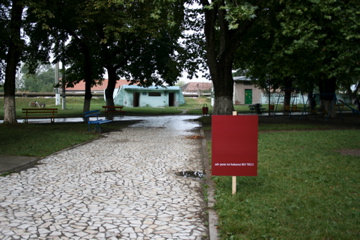Pure paint
dal 10/9/2007 al 26/10/2007
Segnalato da
10/9/2007
Pure paint
Christine Koenig Galerie, Wien
Andreas Reiter Raabe. The employment of photography forces the viewers into a perceptual shift - as they are confronted first by the inherent urgency of the medium. His artwork is essentially abstract, literal and concrete. In the the Third Room: films by Jean Genet and Ed Ruscha selected by artist.

Andreas Reiter Raabe+films by Jean Genet and Ed Ruscha
Born in Austria in 1960, lives and works in Vienna. Studies at University of Vienna
and University of Applied Arts, Vienna. Numerous exhibits since the 90s, including
Sadlers Wells London, DaimlerChrysler Contemporary Berlin, MUMOK Vienna, Ian Potter
Museum Melbourne, Künstlerhaus Bethanien Berlin, Villa Merkel Esslingen,
Wittgensteinhaus Vienna, Secession Vienna, Landesgalerie am Landesmuseum Linz, Sarah
Cottier Gallery Sydney, Hamish McKay Gallery Wellington, Linc Art San Francisco,
Christine König Galerie Vienna.
Reiter Raabe’s photographs provide a series of shifting contexts, both literal and
associational. Documentary photographs that, when compiled into a loose linear
narrative, pose conceptual questions specific to another medium entirely - namely
painting. The results are jarring, disruptive, humorous and - ultimately - probing
of larger issues of meaning.
The employment of photography forces Reiter Raabe’s viewers into a perceptual shift
- as they are confronted first by the inherent urgency of the medium. The resulting
“speed” of photographic visual recognition, along with its accompanying
matter-of-fact veracity, repositions the manner in which the (otherwise by
definition “slow”) paintings are viewed by a general audience. Taking the existing
cultural position of monochrome painting and altering its pre-ordained manner of
receivership. Because his artwork is essentially abstract, literal and concrete,
Reiter Raabe is able to “re-depict” it anew through photography’s traditionally
representational terms.
„The paintings themselves stress surface, procedure and self-restricted methodology.
They typically contain brushed linear elements or poured paint agglomerations that
result in subtly inflected color fields. Stressing automatist process engagement
through the programmatic means of their making, they nonetheless enjoy a specific
personal shared sensibility. He transforms venues to ‚sites’, into which he then
‚inserts’ painted wall surfaces as articulated planes or ‚placed’ objects as willful
disruptions of spatial perception. In a larger sense, his practice could be termed
‚intervention’, a philosophy put into action.“ (John Zinnser)
„The dripping paintings are the opposite and in a certain sense also the negative of
the so called ‚all-over paintings’ although they do not show a traditional structure
of composition, either. The white surface is abstract in a far more radical sense,
since the edges exclude a representation and there cannot be anything within them
which had not been reduced by the artist and could possibly be reconstructed by our
eyes. The artist is operating on the top level of a painting machine; this however,
does not extend his body as a machine but rather restricts it. His painting machine
functions on different levels, which allows for both, for planning and for
coincidence, and which focuses on the very margins, where they meet.“ (Martin
Prinzhorn)
Third Room: films by Jean Genet and Ed Ruscha
selected by Andreas Reiter Raabe
Ed Ruscha
born in Nebraska, US in 1937, lives and works in Los Angeles. Numerous exhibits:
United States representative at the 51st Venice Biennale in 2005, Jeu de Paume
Paris, Museo Nacional Centro de Arte Reina Sofia, San Francisco Museum of Modern
Art, Centre Georges Pompidou, Whitney Museum New York, Museum of Modern Art New
York, Museum of Contemporary Art Los Angeles, National Gallery of Art Washington,
Museum of Contemporary Art Sydney, MOCA Los Angeles, Museum Ludwig Köln.
Ed Ruscha focuses on the narrative possibilities of film: Both of his diverting
films are about wonderful and alluring cars, women and cookies.
Premium, USA 1969/70, 16 mm, 24‘, R: Ed Ruscha
based on the photo book Crackers published in 1969. Subtitle: "How to Derive the
Maximum Enjoyment from Crackers". A film featuring Larry Bell, Leon Bing, Rudi
Gernreich and Tommy Smothers.
Miracle, USA 1975, 16 mm, 28‘44‘‘, R: Ed Ruscha
„…the attitude comes out of a style of living and the taste of things… filtering the
taste with the style of living and then coming up with statements. Like, Miracle is
a product of everything I do, everything I think about, everything I buy… All that
staff goes into the funnel and comes out, la da!“ (quotation from an interview with
Ed Ruscha about the film Miracle)
Jean Genet
Paris 1910 - 1986. Genet wrote novels, plays, poems, and essays, including The
Thief's Journal, Our Lady of the Flowers, The Balcony, The Blacks and The Maids.
Christine König Galerie shows his only film Un Chant d'Amour for the first time in
Austria.
Un Chant d'Amour is Jean Genet's only film, which he directed in 1950. Because of
its explicit homosexual content, the 26-minute movie was long banned and was also
disowned by Genet later in his life. The plot is set in a French prison, where a
prison guard takes voyeuristic pleasure in observing the prisoners perform
masturbatory sexual acts. Genet does not use sound in his film, forcing the viewer
to completely focus on closeups of faces, armpits, and semi-erect penises. The
film's highly sexualized atmosphere has been recognized as a formative factor for
works such as the films of Andy Warhol.
Image: Andreas Reiter Raabe, from the series Natural Monochromes, 2007
Opening 11 September 2007, 7 – 9 pm
Christine Koenig Galerie
Schleifmuehlgasse 1A A-1040 Vienna
Free admission



